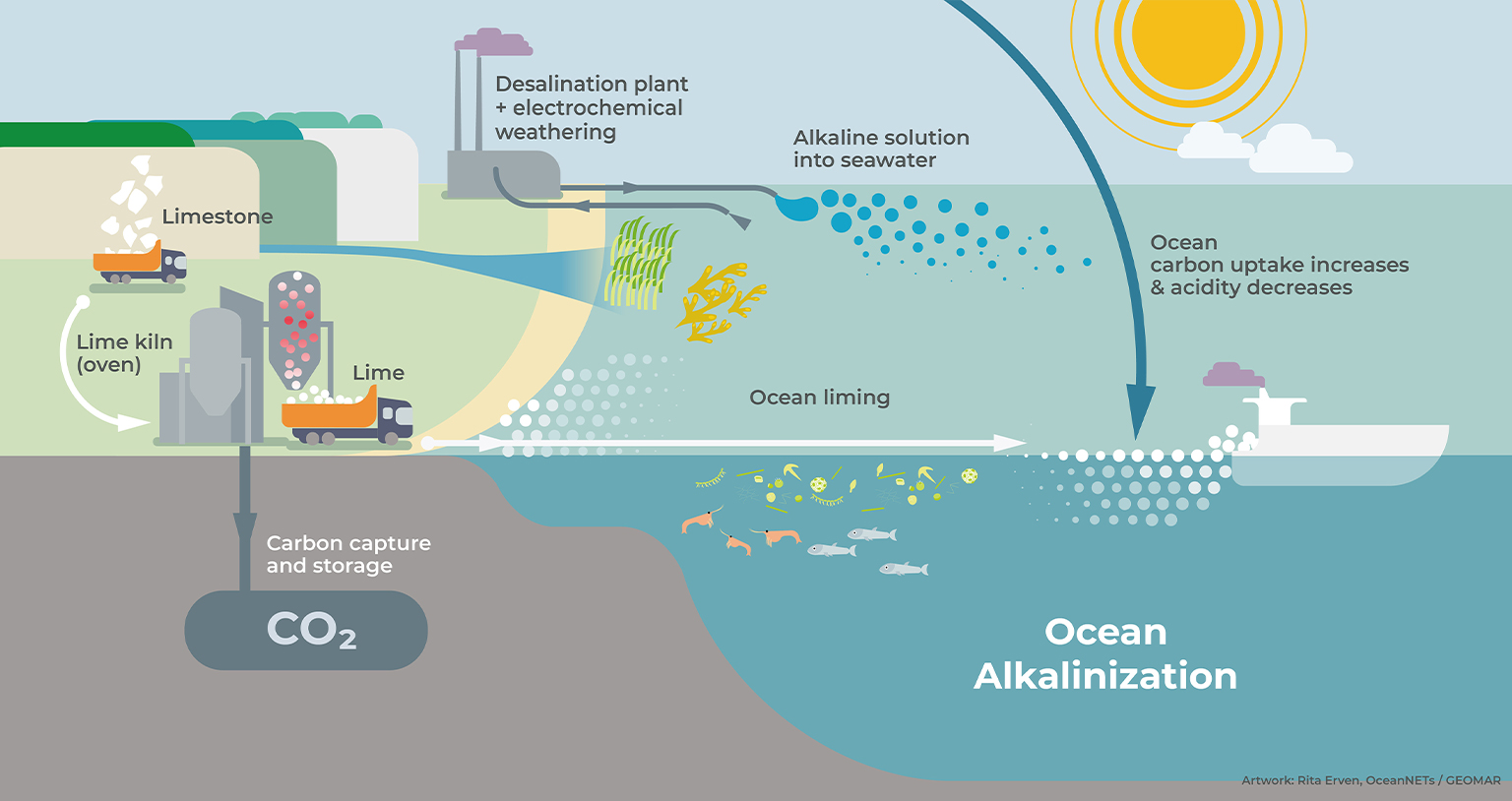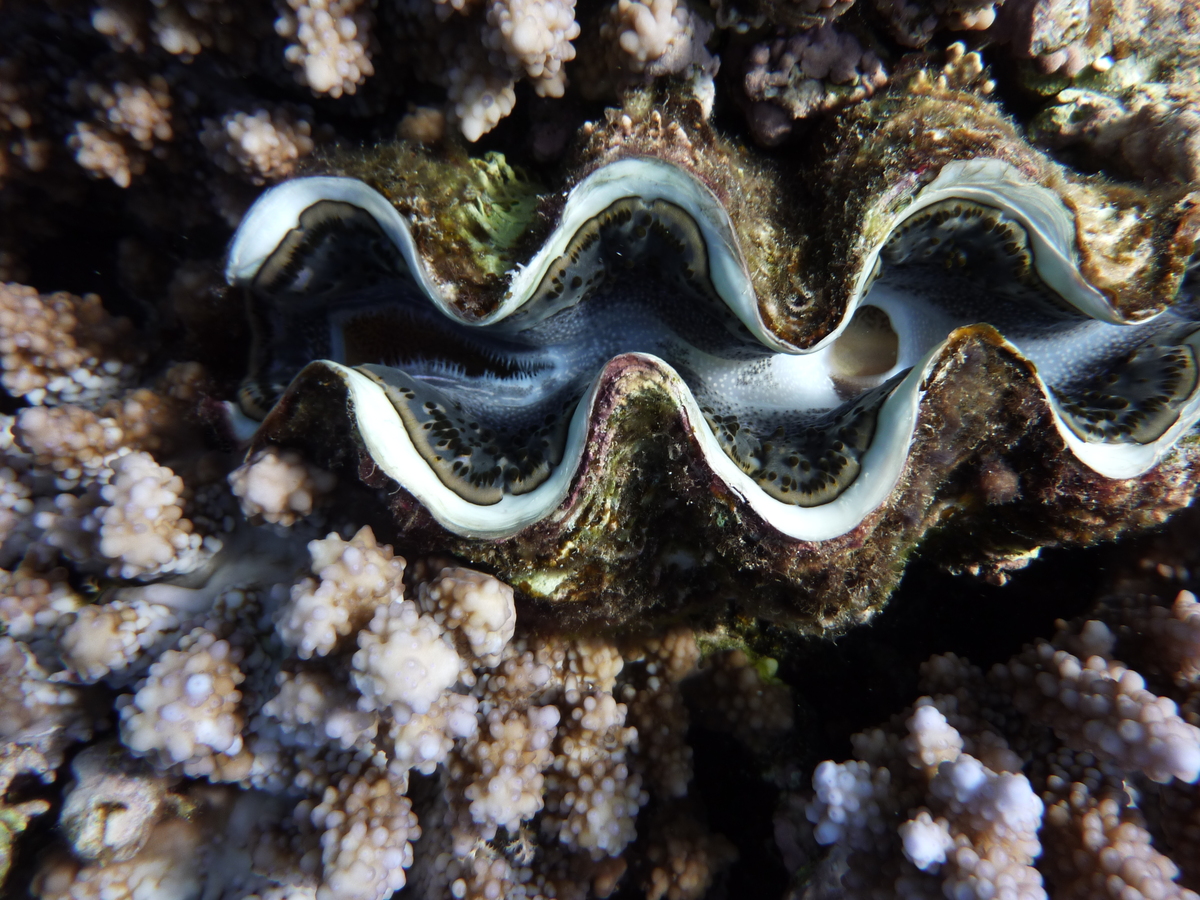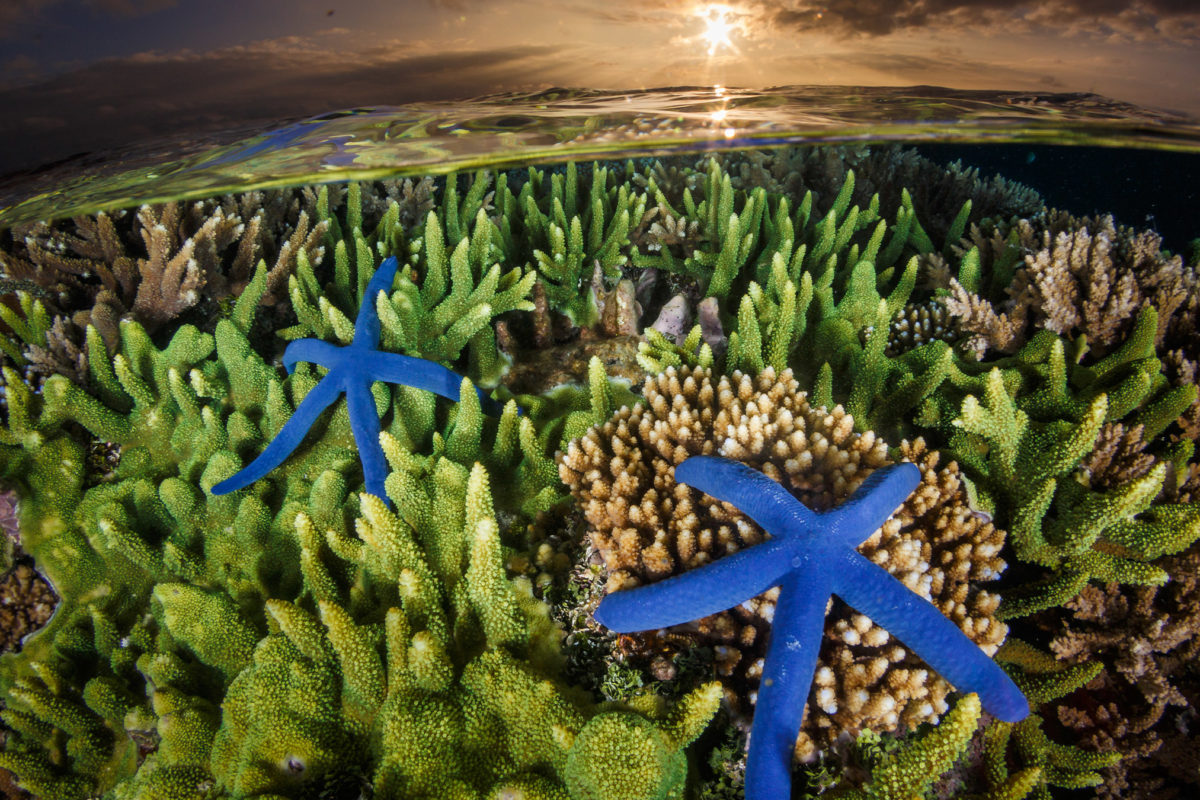- Ocean alkalinity enhancement (OAE) involves releasing certain minerals into the ocean, sparking a chemical reaction that enables the seawater to trap more CO₂ from the air and mitigating, albeit temporarily, ocean acidification.
- Some scientists believe OAE could be a vital tool for drawing down and securely storing some of the excess CO₂ humanity has added to the atmosphere that is now fueling climate change.
- Yet many questions about OAE remain, including most prominently how it would impact marine life and ecosystems.
- Several programs are aiming to spark the research needed to answer these questions, including field tests in the ocean.
Imagine showers of little green sand grains drifting through the ocean: collecting on coral reefs, rolling off the backs of whales, sprinkling schools of tuna — and helping to save all those creatures, and humanity, too. At least that’s the idea.
These green showers are crushed olivine, an abundant volcanic mineral, delivered by a fleet of ships. And it is climate change that launched these thousand ships, crisscrossing the ocean in a surreal bid to undo the damage we’ve done. You see, as the olivine settles on the ocean floor it disintegrates and chemically transforms, making that part of the ocean a little more alkaline and converting dissolved CO2 into carbonate and bicarbonate molecules, a process that stores the carbon for hundreds of thousands of years. The seawater can then trap more CO2 from the air to replace the stored carbon.
Scientists call this ocean alkalinity enhancement, or OAE, and some believe it could be a vital tool for drawing down and securely storing a portion of the 1.5 trillion tons of CO2 that we’ve added to the atmosphere since the industrial revolution, not to mention the billions more we’ll add before we hit net zero.

“Ocean alkalinity enhancements show some outsized promise” in terms of potential cost and permanence of locking away the CO2 compared to other carbon sequestration ideas, said David Koweek, science director at the U.S.-based NGO Ocean Visions.
Moreover, OAE has an additional potential boon mitigating, albeit temporarily, another impact of our fossil fuel addiction: ocean acidification.
Of course, the prospect of dumping boatloads of crushed minerals across the ocean raises some concerns. Researchers like Koweek wonder how it would impact marine life and ecosystems. So they say we need much more research on this idea, including field tests in the ocean.
That research is coming soon, in a big way.
Koweek and Ocean Visions have been evaluating OAE grant proposals in partnership with the Palo Alto California-based NGO Additional Ventures. Co-founded by a former Meta executive, Mike Schroepfer, Additional Ventures has put aside $100 million for OAE research and development. The two NGOs are currently evaluating proposals for two different grants. The first will support projects to develop prototypes of equipment to produce or deliver minerals, with funding ranging from $750,000 to $1.5 million; the second will support projects to explore how OAE could be done safely and effectively, with minimum funding of $10 million. They’ll announce the grant recipients later this year and research will take up to five years.
The U.S. government is also accepting grant applications for researching various methods to remove carbon dioxide and mitigate acidification in marine areas, under NOAA’s Ocean Acidification Program.

The carbon dilemma
The Earth’s global ocean is an unparalleled carbon storehouse. Covering 70.8% of the world’s surface, the ocean stores around 50 times more carbon than the atmosphere and about 20 times more carbon than every plant and plot of soil on land combined. For this reason alone, many scientists are looking to the ocean as a tool against climate change.
The Sixth Report from the IPCC, released in April 2022, found that CO2 removal will be “unavoidable” because some emissions will be “hard to abate” in report-speak — think airplanes. This followed a 2019 report by the National Academies of Sciences, Engineering and Medicine (NASEM) showing that carbon sequestration tools will need to take in around 10 gigatons of CO2 annually by 2050 — more than a quarter of today’s annual emissions.
Some carbon sequestration methods are already in use: reforestation, agroforestry, restoring peatlands and changing agriculture to improve CO2 sequestration in soil. In the ocean, communities are beginning to restore kelp forests, mangroves and other blue carbon powerhouses. And interest is rising in other methods, such as direct air capture and OAE.
None of this negates the need to cut emissions aggressively. Instead, the IPCC is saying we will need to do both: slash emissions and dramatically upscale tools to sequester carbon.
OAE is especially attractive since it mimics nature — only on a faster timescale.
“If we did nothing about the climate problem at all, Earth would rebalance its carbon cycle on the scale of tens to hundreds of thousands of years by weathering silicate minerals on land, and sending that carbon into the ocean in the form of alkalinity,” said Koweek. “And so, ocean alkalinity enhancement is an acceleration of a natural cycle.”

Carbon removal
In December 2021, NASEM released a report looking at six tools to sequester carbon in the ocean, including OAE. The report’s authors expressed “high confidence” in the efficacy of OAE but warned that it could carry “medium environmental risks” and “medium to high scale-up costs.” It called for investments of $125-$200 million to study this method.
There are a few different pathways for ocean alkalinity enhancement. The main ones all involve mining and then releasing minerals or seawater treated with them into the ocean. In addition to distributing olivine — or other silicate rocks — over the ocean, we could turn to limestone. However, the limestone would need to be treated: either fired in a kiln (“ocean liming”) or processed with seawater and CO2 (“enhanced weathering”) before releasing the water back into the sea.
All three methods have drawbacks: They would likely require a lot of energy, they could potentially harm the ecosystem, and they may be difficult to monitor. Mining and crushing minerals is energy-intensive. So is heating limestone in a kiln or a reactor. And those fleets of ships to distribute the minerals all need energy to run.
One of the attractions of OAE is that scientists believe its direct impact on the marine environment would be modest. Current ecological concerns have mainly to do with the effect on the dumping sites. If materials are “increased too quickly” it could hinder photosynthesis at those sites, Phil Renforth, an OAE expert at Heriot-Watt University in Edinburgh, told Mongabay via email.
Another concern is that silicate minerals could add “bioactive elements,” such as iron and silica, which could fertilize the oceans, Renforth said. This fertilization could remove additional CO2 but may come with negative effects on wildlife, such as increasing toxic algae or decreasing the sunlight reaching species.
There is also the impact of mining to consider. Depending on how the mining is handled, it could destroy local natural areas. Running the mining equipment on fossil fuels would decrease the project’s overall carbon benefit and cause pollution.
A final potential downside of OAE is the difficulty of monitoring projects and verifying the amount of carbon they store.
“The challenges for measuring, reporting and verifying for ocean pathways are going to be far more difficult than direct air capture…And so that is likely a barrier to scalability. Now, whether that barrier can be overcome…I don’t know yet,” said Koweek, who added that ocean-based carbon removal credits issued under carbon-trading schemes may “always have to apply a discounting rate.”

Antacid treatment
In 2014, Rebecca Albright, an expert on corals at the time with the Carnegie Institution, worked with colleagues to mix seawater and sodium hydroxide in a tank and then release the solution into the wild in the Great Barrier Reef.
“After mixing, we pumped the [treated] water onto the reef flat and let it traverse the reef flat naturally, bathing the reef with alkaline water, and we measured the calcification response,” said Albright, now with the California Academy of Sciences. “We used a dye tracer to be able to differentiate the treatment water from the ambient seawater.”
The researchers were not trying to test OAE, but to prove once and for all that ocean acidification was a major reason behind coral decline. Their research showed that when they returned the seawater’s chemistry to a more alkaline state — similar to that of the preindustrial past — the coral reefs began to calcify more quickly. In other words, ocean acidification was indeed a culprit.
Ocean acidification happens when seawater absorbs excess CO2 from the atmosphere. Since the Industrial Revolution, ocean acidity has jumped by 30%, making life more difficult for many marine organisms. It has damaged not only coral reefs but oysters and clams as well. Scientists are also concerned about pteropods (free-swimming sea snails and slugs) and some types of phytoplankton as acidity grows. Declines in these species would impact animals higher up the food web.
But Albright’s study had other implications.
“The study…is possibly the first controlled field experiment for Ocean Alkalinity Enhancement,” Lennart Bach, a marine biogeochemist at the Institute for Marine and Antarctic Studies in Battery Point, Australia, wrote on Twitter.

While the primary purpose of OAE would be to sequester large amounts of CO2, the study showed that adding alkaline material to the ocean could help mitigate ocean acidification locally — at least for a short time.
Koweek compared it to giving the oceans a TUMS. Adding treated limestone or olivine essentially gives the ocean a dose of antacid — or alkaline treatment. The dose only works where the material is added and lasts maybe a few months.
Albright and her colleagues’ 2014 experiment was tiny: It lasted 15 days and involved an area of just 800 square meters (8,611 square feet). Could we go bigger?
In 2021, Mathieu Mongin, a biogeochemical modeler with Australia’s CSIRO Marine and Atmospheric Research, published a paper that modeled what might happen if we dumped 30,000 metric tons of olivine across the Great Barrier Reef daily for one year along an existing shipping route to save on ship energy.
The outcome? The material would mitigate about a decade’s worth of acidification on the reefs where it was dumped. It would also sequester about 35,000 tons of carbon, about the same as the annual emissions of more than 27,000 gas-powered cars.
“The largest drawback is as soon as the alkalinity release from the ship stops, the ocean reverts back to its original state [of acidity] in a matter of weeks or months,” Mongin said. “The alkalinity injection needs to be ongoing. This is not the golden apple solution, more part of a large basket of things that we will have to do to bring the system under control.”
What happens is that OAE only decreases acidity initially as the introduced minerals or treated seawater transform the CO2 that’s already in the ocean. When CO2 from the atmosphere seeps in to replace the locked up CO2, the ocean’s acidity bounces back.
Still, OAE could be deployed to mitigate ocean acidification under certain circumstances, such as in places that are particularly vulnerable to acidification or particularly worthy of protection, according to Koweek. Some fisheries are already adding alkaline material to seawater to give shellfish, like oysters, a better chance at survival.

The research needed
No one is advocating large-scale OAE until there is more research. But that research is coming.
Koweek said he’s “interested in controlled field trials” that, like Albright’s study, would test alkaline materials in the ocean, comparing treated to untreated areas.
Understanding the environmental impacts of OAE is one of the main points. Koweek said field trials might have small impacts, but “we shouldn’t confuse the environmental impacts that may occur with a controlled field trial with the potential environmental impacts of scaling this to a gigaton scale industry.”
Research on geoengineering or climate engineering tools has a history of raising concerns. For example, last year Harvard University scientists halted a small-scale test of an air balloon in Finland after local Sami people balked at the study’s goal of testing stratospheric aerosol injections that could potentially cool our overheated planet. In addition, since the 1990s scientists have run a number of studies testing iron fertilization in the ocean, which theoretically would store carbon by spurring plankton blooms. However, some of those studies have drawn criticism for slack science and murky permitting by ocean authorities.
OAE has not faced such criticism to date. To avoid it, Koweek said Additional Ventures and Ocean Visions will do everything by the book: Any OAE research they fund will need to acquire the requisite permission from various authorities, engage “local stakeholders,” and stick to a code of conduct, such as frameworks for research on climate interventions under development by the American Geophysical Union and the Aspen Institute.
The aim of the research is to inform future generations on whether or not OAE is a viable tool — and if so, how best to employ it.
“In addition to the physical and technical limitations, we need to understand the social, ethical, legal and political dimensions of OAE,” said Renforth, who’s exploring this as part of the EU-funded OceanNETs project, which is currently conducting research in “mesocosms” or human-controlled outdoor habitats meant to mimic the sea. “In terms of research, we are only just scratching the surface.”
Banner image: Since the Industrial Revolution, ocean acidification due to humanity’s emission of greenhouse gases has greatly damaged coral reefs. Image by Grant Thomas / Ocean Image Bank.
Acid test: Are the world’s oceans becoming too ‘acidic’ to support life?
Citations:
National Academies of Sciences, Engineering, and Medicine. (2019). Negative Emissions Technologies and Reliable Sequestration: A Research Agenda. Washington, DC: The National Academies Press. doi:10.17226/25259
National Academies of Sciences, Engineering, and Medicine. (2022). A Research Strategy for Ocean-based Carbon Dioxide Removal and Sequestration. Retrieved from doi:10.17226/26278
Albright, R., Caldeira, L., Hosfelt, J., Kwiatkowski, L., Maclaren, J. K., Mason, B. M., … Caldeira, K. (2016). Reversal of ocean acidification enhances net coral reef calcification. Nature, 531(7594), 362-365. doi:10.1038/nature17155
Mongin, M., Baird, M. E., Lenton, A., Neill, C., & Akl, J. (2021). Reversing ocean acidification along the Great Barrier Reef using alkalinity injection. Environmental Research Letters, 16(6), 064068. doi:10.1088/1748-9326/ac002d
FEEDBACK: Use this form to send a message to the editor of this post. If you want to post a public comment, you can do that at the bottom of the page.
